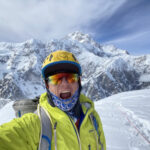Embarking on your first guided rock climbing adventure is an exhilarating experience, but ensuring you have the right gear is paramount for a safe and enjoyable climb. While your guide will handle the technical equipment, it’s essential to come prepared with your personal gear tailored to your climbing experience. Let’s delve deeper into each gear category based on your climbing proficiency:
Must-Haves for Beginner Climbers
Climbing Shoes
The cornerstone of your climbing gear, a properly fitted pair of climbing shoes can significantly enhance your performance and comfort on the rock. While many guides offer rental options, investing in your pair can provide a more personalized fit and feel. Consult your guide for recommendations on beginner-friendly shoes suited to the types of climbs you’ll encounter.
Comfortable Clothing
In the ever-changing mountain weather, layering is key to staying comfortable and prepared for any conditions. Begin with moisture-wicking base layers to keep sweat at bay, followed by a lightweight fleece or insulated jacket for warmth. Don’t forget to pack a waterproof shell to shield against unexpected rain showers. Opt for climbing-friendly pants or shorts that offer freedom of movement without excess bulk.
Sun Protection
Spending extended periods exposed to the sun’s rays at altitude necessitates adequate sun protection. Pack high SPF sunscreen, polarized sunglasses to reduce glare, and a wide-brimmed hat for added protection. Even on overcast days, UV radiation can be intense, so ensure you’re adequately covered. Invest in a climbing-specific helmet designed to shield against both falling rocks and potential upward falls, providing an additional layer of safety.
Hydration & Snacks
Climbing is physically demanding, and staying hydrated and fueled throughout your adventure is crucial. Bring along a sizable water bottle or hydration reservoir to ensure you have an ample supply of fluids. Pack easily accessible high-energy snacks like trail mix, energy bars, or fresh fruit to replenish energy levels during breaks. Maintaining proper hydration and nutrition will help optimize your climbing performance and overall enjoyment.
Small Backpack
A comfortable and lightweight daypack serves as your mobile basecamp, carrying essential gear and provisions for the day’s climb. Look for packs with ergonomic designs and padded straps for optimal comfort during extended wear. Some packs feature dedicated hydration bladder sleeves, providing convenient access to water while on the move. Choose a size that accommodates your essentials without adding unnecessary bulk.
Good to Have for Intermediate Climbers
Climbing Harness
As you progress in your climbing journey, owning a personal harness becomes increasingly beneficial. Familiarity with your harness not only enhances comfort but also instills confidence during climbs. Ensure your harness is in pristine condition, free from any signs of wear or damage, to guarantee optimal safety while on the rock.
Chalk Bag & Chalk
Maintaining dry hands is essential for maintaining a secure grip on the rock surface. Invest in a chalk bag and quality climbing chalk to absorb moisture and enhance friction. Chalk bags come in various designs, ranging from simple drawstring pouches to models equipped with zippered pockets for storing small essentials. Experiment with different chalk types to find the one that best suits your climbing style and preferences.
Belay Gloves (Optional):
While not essential, belay gloves can offer added protection and comfort during extended belay sessions, particularly when using thinner ropes. These specialized gloves shield your hands from friction and heat generated during belaying, minimizing the risk of abrasions and discomfort. Consider investing in a pair if you frequently engage in multi-pitch climbs or prolonged belay stances.
Approach Shoes (Location-Specific)
For climbs requiring an extended or technical approach, specialized approach shoes provide superior traction and support compared to conventional sneakers. These hybrid footwear options offer the grip and stability needed for navigating rugged terrain, ensuring you arrive at the base of your chosen climb safely and comfortably. Consult with your guide to determine if approach shoes are necessary based on the terrain and conditions of your planned ascent.
Advanced Climber Extras
Personal Anchor System (PAS)
As you tackle more challenging climbs, a personal anchor system (PAS) becomes a valuable addition to your gear arsenal. This versatile piece of equipment allows you to securely clip into anchors at the top of multi-pitch routes, providing added safety and stability during belay transitions and rest stops. Discuss the preferred type of PAS with your guide to ensure compatibility with your planned climbs and personal preferences.
Additional Belay Device
While your guide will supply a belay device, having your own can streamline the climbing process and enhance familiarity with the equipment. Confirm with your guide the preferred type of belay device for the specific climb, whether it’s an ATC-style device, a Grigri, or another model. Carrying your belay device ensures you’re prepared for any situation and promotes a smoother climbing experience.
Quickdraws (If Lead Climbing)
If you’re venturing into lead climbing territory, quickdraws are essential for protecting yourself on the ascent. Confirm with your guide whether they provide quickdraws or if you need to bring your own. The number of quickdraws required depends on the length and style of routes you’ll be climbing, so be sure to pack an adequate supply. Invest in high-quality quickdraws with durable construction and reliable gate action for added peace of mind on the rock.
Helmet
While safety is paramount in all climbing endeavors, having your helmet ensures a proper fit and maximum protection. Climbing helmets are designed to safeguard against impacts from falling debris and accidental falls, reducing the risk of head injuries. Prioritize comfort and ventilation when selecting a helmet, opting for models with adjustable retention systems and ample ventilation ports for enhanced airflow.
What Your Guide Will Provide
Ropes, Helmets & Safety Equipment:
Your guide serves as the cornerstone of safety on your climbing adventure, providing essential equipment such as ropes, helmets, and other safety gear. Rest assured that your guide has meticulously inspected and maintained all gear to ensure optimal performance and reliability.
Technical Hardware:
From carabiners and belay devices to quickdraws and anchor-building gear, your guide comes equipped with a comprehensive array of technical hardware necessary for safe and efficient climbing. Trust in your guide’s expertise and experience to select the appropriate equipment tailored to the specific demands of your climb.
First-Aid Kit:
Accidents and injuries can occur, even in the controlled environment of guided climbs. Your guide is equipped with a first-aid kit stocked with essential supplies to address minor scrapes, blisters, and other common ailments encountered during climbing excursions. Rest easy knowing that your guide is prepared to handle any medical situation that may arise with professionalism and efficiency.
Tips for Packing Success
Ask Your Guide
Your guide is your most valuable resource when it comes to gear preparation. Reach out to your guide well in advance to obtain a comprehensive gear list tailored to the specific climb, location, and season. By following their recommendations, you can ensure you’re adequately equipped for a successful and enjoyable climbing experience.
Weather Matters
Stay abreast of the latest weather forecasts for your climbing destination and adjust your gear selection accordingly. Mountain weather can be unpredictable, with conditions changing rapidly. Pack versatile clothing options that can adapt to fluctuating temperatures and weather patterns, ensuring you’re prepared for whatever Mother Nature throws your way.
Comfort is Key
Climbing is a physically demanding activity, and comfort plays a crucial role in your overall enjoyment and performance. Prioritize well-fitting clothing and footwear to minimize discomfort and distractions on the rock. Take the time to break in new shoes before your climb to prevent blisters and hot spots. Pack essential items such as extra layers, snacks, and hydration to keep you comfortable and energized throughout your adventure.
Less is Often More
When it comes to packing for a climbing excursion, simplicity is key. Avoid overpacking unnecessary items that can weigh you down and impede your mobility on the rock. Focus on packing only the essentials recommended by your guide, trusting in their expertise to handle the rest. By traveling light, you’ll enjoy greater freedom of movement and a more streamlined climbing experience.
Our Rock Climbing Guides: Your Partners in Adventure

Vince Anderson
An IFMGA certified rock climbing guide with an adventurous spirit and decades of experience. Vince is known for his alpine expertise and has climbed extensively on Colorado’s big peaks.

Steven Van Sickle
An IFMGA/AMGA certified rock climbing guide specializing in technical alpine routes and big mountain adventures. Steven loves exploring the high peaks of the San Juans and beyond.

Buster Jesik
An accomplished climber and certified rock climbing guide, Buster brings knowledge and passion for routes throughout the state, from the Front Range to the Western Slope.

Katie Beringer
A passionate rock climber, ice climber, and AMGA certified rock climbing guide, Katie’s enthusiasm is infectious, whether you’re a beginner or pushing your grade.
Ready to take your climbing to new heights?
With a guiding service, conquer classic routes in Boulder, explore the complex limestone in Rifle, tackle adventurous multi-pitches in the Black Canyon, experience the climbing mecca of Ouray, or venture into the desert towers of Moab or Grand Junction. A rock climbing guide unlocks the full potential of these incredible destinations.
